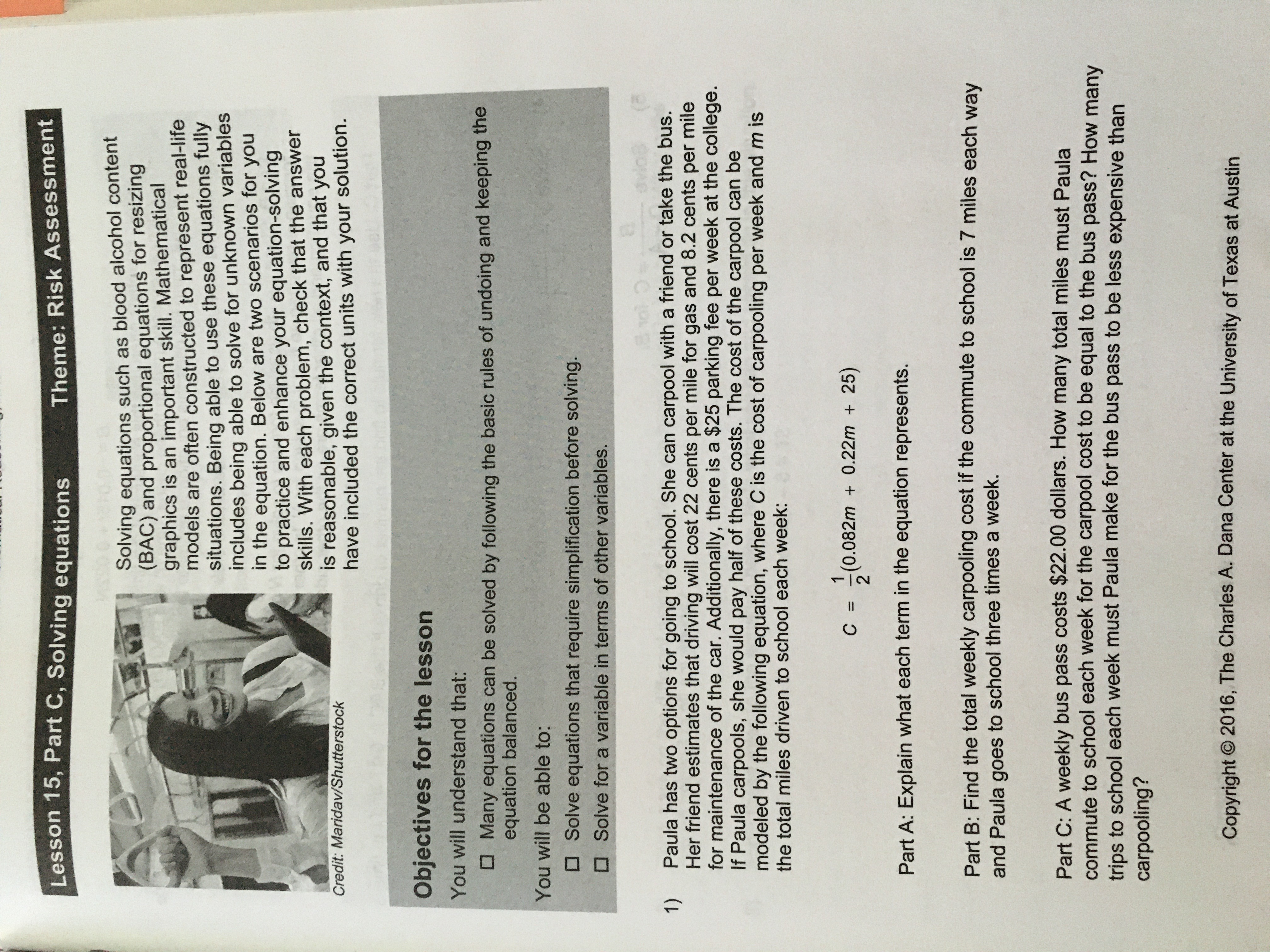
Advanced Engineering Mathematics
10th Edition
ISBN: 9780470458365
Author: Erwin Kreyszig
Publisher: Wiley, John & Sons, Incorporated
expand_more
expand_more
format_list_bulleted
Question

Transcribed Image Text:Lesson 15, Part C, Solving equations
Theme: Risk Assessment
Solving equations such as blood alcohol content
(BAC) and proportional equations for resizing
graphics is an important skill. Mathematical
models are often constructed to represent real-life
situations. Being able to use these equations fully
includes being able to solve for unknown variables
in the equation. Below are two scenarios for you
to practice and enhance your equation-solving
skills. With each problem, check that the answer
is reasonable, given the context, and that you
have included the correct units with your solution.
Credit: Maridav/Shutterstock
Objectives for the lesson
You will understand that:
O Many equations can be solved by following the basic rules of undoing and keeping the
equation balanced.
You will be able to:
O Solve equations that require simplification before solving.
O Solve for a variable in terms of other variables.
Paula has two options for going to school. She can carpool with a friend or take the bus.
1)
Her friend estimates that driving will cost 22 cents per mile for gas and 8.2 cents per mile
for maintenance of the car. Additionally, there is a $25 parking fee per week at the college.
If Paula carpools, she would pay half of these costs. The cost of the carpool can be
modeled by the following equation, where C is the cost of carpooling per week and m is
the total miles driven to school each week:
C = (0.082m + 0.22m + 25)
%3D
Part A: Explain what each term in the equation represents.
Part B: Find the total weekly carpooling cost if the commute to school is 7 miles each way
and Paula goes to school three times a week.
Part C: A weekly bus pass costs $22.00 dollars. How many total miles must Paula
commute to school each week for the carpool cost to be equal to the bus pass? How many
trips to school each week must Paula make for the bus pass to be less expensive than
carpooling?
Copyright © 2016, The Charles A. Dana Center at the University of Texas at Austin
Expert Solution
This question has been solved!
Explore an expertly crafted, step-by-step solution for a thorough understanding of key concepts.
This is a popular solution
Trending nowThis is a popular solution!
Step by stepSolved in 3 steps with 6 images

Knowledge Booster
Similar questions
- Course Messages Gradebook Home > MT180 Summer 2024 > Assessment Assignment 2.3 Score: 8.67/13 9/13 answered Question 11 An eastbound train and a westbound train meet each other on parallel tracks heading in opposite directions. The eastbound train travels & miles per hour faster than the westbound train. After 2 hours, they are 260 miles apart. At what speeds are the two trains traveling? Write an equation using the information as it is given above that can be used to solve this problem. Use the variable r to represent the speed of the westbound train. Equation: The eastbound train is traveling The westbound train is traveling Question Help: Message instructor Calculator Submit Question mph. mph. útv 24 C NAarrow_forwardEquation of a linearrow_forwardhelp pleasearrow_forward
arrow_back_ios
arrow_forward_ios
Recommended textbooks for you
 Advanced Engineering MathematicsAdvanced MathISBN:9780470458365Author:Erwin KreyszigPublisher:Wiley, John & Sons, Incorporated
Advanced Engineering MathematicsAdvanced MathISBN:9780470458365Author:Erwin KreyszigPublisher:Wiley, John & Sons, Incorporated Numerical Methods for EngineersAdvanced MathISBN:9780073397924Author:Steven C. Chapra Dr., Raymond P. CanalePublisher:McGraw-Hill Education
Numerical Methods for EngineersAdvanced MathISBN:9780073397924Author:Steven C. Chapra Dr., Raymond P. CanalePublisher:McGraw-Hill Education Introductory Mathematics for Engineering Applicat...Advanced MathISBN:9781118141809Author:Nathan KlingbeilPublisher:WILEY
Introductory Mathematics for Engineering Applicat...Advanced MathISBN:9781118141809Author:Nathan KlingbeilPublisher:WILEY Mathematics For Machine TechnologyAdvanced MathISBN:9781337798310Author:Peterson, John.Publisher:Cengage Learning,
Mathematics For Machine TechnologyAdvanced MathISBN:9781337798310Author:Peterson, John.Publisher:Cengage Learning,


Advanced Engineering Mathematics
Advanced Math
ISBN:9780470458365
Author:Erwin Kreyszig
Publisher:Wiley, John & Sons, Incorporated

Numerical Methods for Engineers
Advanced Math
ISBN:9780073397924
Author:Steven C. Chapra Dr., Raymond P. Canale
Publisher:McGraw-Hill Education

Introductory Mathematics for Engineering Applicat...
Advanced Math
ISBN:9781118141809
Author:Nathan Klingbeil
Publisher:WILEY

Mathematics For Machine Technology
Advanced Math
ISBN:9781337798310
Author:Peterson, John.
Publisher:Cengage Learning,

